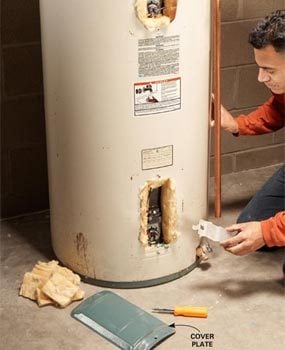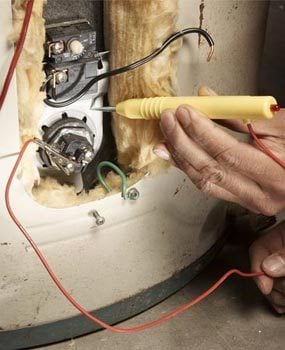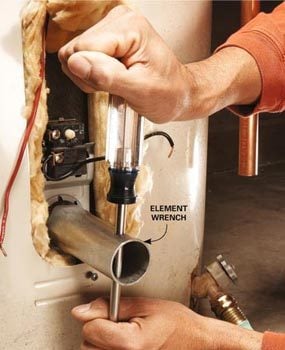How Do You Know When a Element in a Heater Goes Out
DIY Water Heater Testing and Repair
A one-hour DIY repair that will save you the cost of calling the plumber
Introduction
Heating elements on electric h2o heaters sometimes neglect long before the water heater, but replacing them in a hot water heater is an easy DIY repair.
Tools Required
Materials Required
- Heating elements
If your electric hot water heater is wearisome to heat, runs out of hot water faster than it used to, or doesn't deliver any hot h2o at all, there's a xc percent take a chance that simply replacing one or both of the heating elements will solve the problem. Water heater repairs are straightforward, and replacement elements are inexpensive ($8 to $twenty) and readily bachelor at dwelling house centers, hardware stores and appliance parts dealers.
Nosotros'll show you how to test the heating elements, remove ane if it's bad, and install a new i. Only keep in heed that water heaters accept a typical life span of 10 to fifteen years. If your heater is approaching onetime historic period, replacement may exist smarter than repair.
Learn how to regulate your water heater here.
Other Causes of Water Non Getting Hot
Of grade, in that location are other potential causes of a lack of hot h2o. Before you examination the elements, cheque to make sure the circuit breaker is on and not tripped. Also press the reset button on the high-temperature cutoff located just above the upper thermostat. Resetting either the circuit breaker or the high-temperature cutoff may resolve the problem, simply the fact that they were tripped in the starting time identify may betoken an electric problem. If they trip over again, test the heating elements.
If the heating elements are proficient, the problem could exist with the thermostats or cutoff switch. Testing is complicated, merely since they're inexpensive—virtually $20 for both thermostats and the cutoff switch—y'all could just try replacing them.
Video: How to Test Your Water Heater Element
Project step-past-step (six)
Footstep 1
Remove the Cover Plates
- Turn off the power at the circuit breaker.
- Remove the metal covers to expose the thermostats and elements.
- Pro tip: Make sure the ability is off by touching the electrical connections with a noncontact voltage detector.

Step 2
Examination the Wires
- Test the wires leading into the water heater.
- Note: If the wires are covered by metallic conduit, the tester won't read voltage. You'll have to remove the metal thermostat cover on the side of the water heater, pull out the insulation and hold the tester near the wires leading into the top of the loftier-temperature cutoff switch.
- Concur the tester against the metal h2o heater trounce.
- Note: If the tester doesn't calorie-free upward, it's safe to test the elements.
What'south Within a Water Heater and How Information technology Works
Most residential electrical water heaters take ii heating elements: 1 most the summit of the tank and one near the bottom. Power enters the tiptop and runs to the high-temperature cutoff switch, and and so to the thermostats and elements. The top and bottom elements are controlled by separate thermostats. When the water on the top of the tank is hot, the top element turns off and the lower one heats. The upper and lower heating elements never come on at the same time.
Step three
Exam Continuity for a Burned-Out Element
-
- Note: Yous'll need a continuity tester ($five to $10) for this pace.
- Disconnect the wires from the terminal screws.
- Clip the alligator clamp onto one of the element screws.
- Touch the other screw with the tester probe.
- Note: If the tester doesn't light, replace the element.

Step iv
Test for a Short Circuit
- Clip the alligator prune to i of the element screws.
- Bear on the tester probe to the element mounting subclass.
- Repeat on the other screw.
- Notation: If the tester light comes on either time, there'southward a short. Replace the element.

The Secret of the Red Push
Rarely, both elements volition test okay, simply you're still not getting hot h2o. Attempt pushing the push button on the "high-temperature cutoff," located but to a higher place the upper thermostat. It may solve the problem, but if the problem recurs, cheque your heating elements.
Step 5
Remove the Bad Element
- Close the cold-water inlet valve.
- Open up the hot h2o faucet in the kitchen.
- Connect a garden hose to the drain valve and open it to bleed the tank.
- Note: For thread-in–type elements similar we show here, y'all'll need a h2o heater element wrench ($5 at home centers and hardware stores).
- Unscrew the one-time element using a heating element wrench.
- Pro tip: You lot'll need a long, sturdy Phillips screwdriver to turn the socket. If it won't unscrew, use a cold chisel and hammer to loosen the threads.

Step six
Install the New Element
- Thread the new chemical element into the water heater and tighten information technology with the heating element wrench.
- Reconnect the wires, making sure the connections are tight.
- Supercede the insulation and metal covers.

Buying Heating Elements
Replace your heating element with one of the same wattage. If your old element isn't labeled with the wattage, refer to the nameplate on the water heater or your instruction manual, or search online using the model number from the nameplate.
Heating elements are held to the water heater either with a large thread and nut as shown here or by four bolts and nuts. Most home centers stock the version we testify, but you can buy an adapter kit if you're replacing the four-commodities version.
Elementary U-shape elements are the cheapest. More expensive low-density elements are usually folded back. These provide the same amount of heat but spread out over a larger surface area, which lowers the surface temperature, making them less prone to mineral buildup.
If your erstwhile element was caked with minerals, replace it with a low-density element for more than efficient operation and longer life.
Source: https://www.familyhandyman.com/project/diy-hot-water-heater-repair/
0 Response to "How Do You Know When a Element in a Heater Goes Out"
Post a Comment